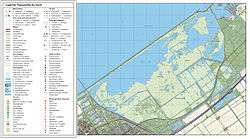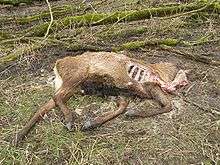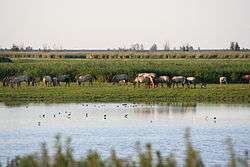Oostvaardersplassen
| Oostvaardersplassen | |
|---|---|
|
Koniks in the Oostvaardersplassen | |
 Geographical map of the Oostvaardersplassen | |
| Location | Flevoland, Netherlands |
| Nearest city | Lelystad |
| Coordinates | 52°27′N 5°22′E / 52.450°N 5.367°ECoordinates: 52°27′N 5°22′E / 52.450°N 5.367°E |
| Area | 56 km2 (22 sq mi) |
| Established | 1968 |
| Governing body | Staatsbosbeheer |
The Oostvaardersplassen (Dutch pronunciation: [oːstˈfaːrdərsˌplɑsə(n)]) is a nature reserve in the Netherlands, which is managed by the State Forestry Service. Covering about 56 square kilometres (22 sq mi), it is noted as an example of rewilding.[1] It is in a polder which was created in 1968, but in spite of the environment having little time to develop, by 1989 it had international importance as a Ramsar wetland.[2]
Geography
The Oostvaardersplassen are located in the municipality of Lelystad, between the towns of Lelystad and Almere, in the province of Flevoland in the Netherlands. The area of 56 square kilometres (22 sq mi) is situated on the shore of the Markermeer in the center of the Flevopolder. The Oostvaardersplassen can be divided into a wet area in the northwest and a dry area in the southeast.
Wet and dry areas
In the wet area along the Markermeer, there are large reedbeds on clay, where moulting geese often feed. This area is also home to great cormorant, common spoonbill, great egret, white-tailed eagle and Eurasian bittern, among many other animals. Oostvaardersplassen is a Special Protection Area for birdlife.[3]
Before the establishment of the reserve, the dry area was a nursery for willow trees, and in the first year hundreds of seedlings could be found on each square metre. This led to concern that a dense woodland would develop, significantly reducing the value of the habitat for water birds. To avoid this, the park's managers brought in a number of large herbivores to keep the area more open, including Konik ponies, red deer and Heck cattle. These large grazing animals are kept out in the open all year round without supplemental feeding, and are allowed to behave as wild animals (without, for example, castrating males). The ecosystem developing under their influence is thought to resemble those that would have existed on European river banks and deltas before human disturbance. However, there is some controversy about how natural the ecosystem is, as it lacks top predators.[1]
Large herbivores
Before they were driven to extinction, large herbivores in this part of Europe included the tarpan (wild horse), wisent (European bison), red deer (elk or wapiti in North America) and aurochs (wild cattle). The tarpan and aurochs are extinct, but Konik ponies and Heck cattle are able to act as functional equivalents, occupying a similar ecological niche. The only native large herbivores now missing from Oostvaardersplassen are the elk (moose in North America), the wild boar and the wisent. There is a chance that the wild boar will find its way naturally from the Veluwe.
| Head count | 2010 [4] | 2011 [5] |
| Red deer | 2,200–2,800 | 3,300 |
| Konik ponies | 1,090 | 1,150 |
| Heck cattle | 320 | 350 |
| Roe deer | 30–40 | n/a |
Natural processes

Given that the Oostvaardersplassen is below sea level, many of its primary processes have been regulated. As the wetlands have been so spectacular, a dyke was made around it to prevent the process of groundwater-related subsidence. While this had temporary advantages, it created a water body with no open connections to the rest of the polder and the negative effects are only now being understood.
The cattle, deer and horses have multiplied in the Oostvaardersplassen. However, there is a limit to the number of animals the area can sustain. In the absence of natural predators the rangers shoot animals that are unlikely to survive. It is quite common for 30 to 60 per cent of the population to die in this way. After a die off, the vegetation has a chance to recover and this will get the first natural afforestation of the area under way.
The large herbivore die-offs are also closely related to the confined nature of the reserve and the flat nature of the reclaimed land, with very little shelter. It is fenced, and thus the large herbivores are unable to migrate away from the over grazed areas in Winter to find either shelter or forage.[6] All the large herbivores have an annual cycle of nutrition. Typically in winter and early spring their metabolism slows down. This is also the period in which they are designed to lose condition (body fat). This is where the ability to seek shelter as they would in a natural environment becomes crucial. Effectively the reserve is too small and impoverished to accommodate the natural processes of large herbivores, as for example in the Serengeti where large herbivores migrate over large distances.
During a particularly harsh winter in 2005, many animals in the Oostvaardersplassen died of starvation, leading to public outcry against alleged animal cruelty.[7]
Future development
In many ways the Oostvaardersplassen is an isolated area; it is in a polder and there are currently no corridors connecting it to other nature reserves. The "Ecological Main Structure" plan proposes connections between nature reserves in the Netherlands, calls for a corridor to be created toward nearby Horsterwold. The resulting network, called Oostvaardersland, would be part of Natura 2000, the European-wide network of habitats to which Oostvaardersplassen belongs.[8] The creation of Oostvaardersland will allow seasonal small scale migration and take some strain off the big grazers in winter. In the summer, Oostvaardersplassen will offer rich grazing and the sea winds will keep biting insects at bay, in the winter, the Horsterwold will offer protection from cold winds and supply browse. Oostvaardersland will comprise a total area of 150 square kilometres (58 sq mi). Furthermore, there is an option for a connection to the Veluwe forest. Eventually this could allow wild animals to move to and from Germany.[9]
Oostvaardersland was expected to be finished by 2014. However, the project ran into financial and political troubles. In 2012 the creation of Oostvaarderswold, the 7 × 1 mi connecting corridor between Oostvaardersplassen and the Horsterwold, was stopped, and four members of the regional parliament resigned.[10] The government then planned to sell back the property to the previous owners for less money than it originally paid for the property; according to European nature laws it would then have to turn other lands into wilderness areas to compensate for the loss of the Oostvaarderswold nature area.[11] The reasons for this plan of action, which would cost a lot of public money and make the future creation of Oostvaardersland impossible, are unclear.
The advocates of natural processes are also planning for the wet part of the Oostvaardersplassen to be drained. It is expected that the natural subsidence will lower the ground level and that this will result in a more natural and dynamic system.
See also
References
- 1 2 Oostvaardersplassen is discussed, for example, in George Monbiot's book Feral: Searching for Enchantment on the Frontiers of Rewilding (2013). While being in favour of rewilding, Monbiot has doubts about this site's lack of tree cover and of predators.
- ↑ "Important Bird Areas factsheet". Downloaded from http://www.birdlife.org. Retrieved July 29, 2012. External link in
|publisher=(help) - ↑ "EUNIS -Site factsheet for Oostvaardersplassen". Eunis.eea.europa.eu. Retrieved 2013-02-07.
- ↑ Nederlands staatsbosbeheer (12 April 2011). "Managementplan Oostvaardersplassengebied 2011 - 2015" (PDF).
- ↑ Nederlands staatsbosbeheer (Autumn 2011). "Oostvaardersland Seizoensbericht – najaar 2011" (PDF).
- ↑ Kite, Melissa (22 February 2014), "The Environment Agency cares more about wildlife than people", The Spectator, London, archived from the original on 28 February 2014
- ↑ Reardon, Sara (28 February 2014), "Rewilding: Bring in the big beasts to fix ecosystems", New Scientist (2958), archived from the original on 28 February 2014
- ↑ (Dutch) Natura 2000 'Oostvaardersplassen'
- ↑ L. Verbeek (Queen’s Commissioner of the Province of Flevoland), A.E. Bliek-de Jong (Deputy Queen's Commissioner) (October 2010). "Oostvaardersland. Strengthening biodiversity and the economy in the Netherlands" (PDF). Presentation at the Convention on Biological Diversity, Nagoya, Japan. Retrieved 20 August 2013.
- ↑ "Status OostvaardersWold". Provincie Flevoland. Retrieved 20 August 2013.
- ↑ "Van Gerven: 'Verkoop natuurgrond Oostvaarderswold is pure vernietiging'". SP website. 11 April 2012. Retrieved 20 August 2013.
External links
| Wikimedia Commons has media related to Oostvaardersplassen. |
- (Dutch) Oostvaardersplassen at the website of Staatsbosbeheer

